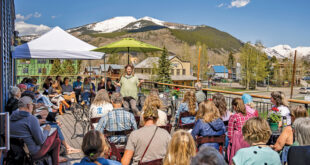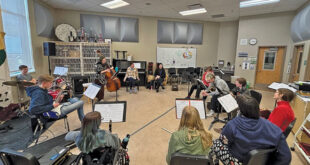“Wassail! wassail! all over the town, our toast it is white and our ale it is brown;
“Our bowl it is made of the white maple tree; with the wassailing bowl, we’ll drink to thee.”
—The Gloucestershire Wassail, an incantation sung in the Middle Ages
“There is an ancient Celtic axiom that says ‘Good people drink good beer.’ Which is true, then as now. Just look around you in any public barroom and you will quickly see: Bad people drink bad beer. Think about it.”
—Hunter S. Thompson
Just when you thought you couldn’t possibly partake of another holiday party, along comes New Year’s Eve. ’Tis the season of overindulgence—from spending to eating to alcohol merriment—and it tends to bring out the amateurs. It’s the one holiday when even reasonable, well-behaved adults will engage in the insanity of excess and do silly things they wouldn’t normally ever do.
This is the Superbowl for the harbingers of the New Year and celebrate we must, as did our ancient ancestors. Although Crested Buttians have more practice than many when it comes to tipping the glass in celebration, frankly, ancient Roman times and the Middle Ages were, unbelievably, even more raucous.
The beginning of a new year has been celebrated as far back as time has been recorded and usually coincided with astrological or agrarian events. Four thousand years ago, the ancient Babylonians celebrated the new year with the first new moon following the vernal equinox in late March. They were the first to make new year resolutions (presumably, the first to break them, too).
The annual flooding of the Nile and the rising of the star Sirius heralded in the new year for ancient Egyptians. The Chinese new year coincided with the second new moon after the winter solstice. In ancient Rome, the new year was celebrated with the vernal equinox until Julius Caesar introduced the Julian calendar and declared the first day of the month of Januarius to be the new year. Since Janus was the god of doors, gates and beginnings, and he had two faces—one looking back and one to the future simultaneously—the new year date was deemed appropriate and the party began. Make no mistake, the Romans knew how to party—sacrifices to Janus, exchanging gifts, festive greenery decorations, and of course, those notoriously licentious parties that went down into the annals of history.
Much later, in medieval Europe, Christian leaders tried to give the holiday a much more somber significance by declaring January 1 as the day of Christ’s circumcision. Fortunately, the country folk refused to give up their feasting and revelry and on “Newyere Daie” during the Middle Ages of England, they would drink to each other’s health saying, “Waes hael!” literally meaning, “Be healthy!” to which the response would be, “Waes drinc!” which translates as “Drink in good health!” Wassailing is actually a ritual, a blessing and a singing ceremony to the orchard to scare away evil spirits and awaken the apple trees, ensuring a good fall harvest. Like Crested Butte’s Flauschink, there’s a King and Queen and they drink copious amounts of wassail before parading, but this royalty went from orchard to orchard, where the Queen hung pieces of toast soaked in wassail on the branches as a gift to the tree spirits.
A type of wassail drink actually dates back to those hedonistic Romans who would cut wine with water, add honey and spices and boil it down for their celebrations. They called it “calda.” Wassail drink of the Middle Ages consisted of mulled brown ale or mead, sugar, ginger, and nutmeg, heated in a bowl and topped with slices of toast. It was consumed at Christmas and Twelfth Night (or Epiphany), and new year celebrations. Bowls were passed around and shared by all, and for good measure, they’d pour a bit more on the trees.
Christian Roman emperors tolerated the new year customs but the effort to eliminate what they considered idolatrous rites ended badly, with the church eventually prohibiting its members from observing it in any way with revelry. Rest assured that every era had its puritans trying to put a stop to life’s enjoyment—even here in the Land of the Free.
Although A. E. Housman (Victorian-era British poet) was quoted as declaring, “…And malt does more than Milton can to justify God’s ways to man,” the United States had its own dark ages concerning the imbibing of alcohol, known as Prohibition, which lasted almost 14 tumultuous years. The New Year’s Eve celebration before the law went into effect saw most of the population of America in a delirious end-of-the-world drinking binge. The 18th Amendment, passed into law in 1919, prohibiting the production, sale and transporting of any intoxicating liquids for consumption, was the result of the war waged by the Anti-Saloon League and the Women’s Christian Temperance Union movements. The U.S. government lost billions in tax revenues because of it.
The booze-free frenzy came out of reasonable enough ideals: drunks would come home from the bars after work and beat their wives and abuse the kids.
Employers noted that drinking was cutting production at work. It seemed patriotic enough, but it’s far easier to outlaw something for the masses, like the enjoyment and production of alcohol, than it is to enforce that law, as the government discovered. People liked their traditions, and the taste of their brews, gin, rye, rum and other libations and ale and liquor were pretty easy to make at home, or to sell in the speakeasies that popped up. However, it’s estimated that 10,000 people died of alcohol poisoning during Prohibition, not only from bad bootlegging but from a federal government program that added poison to alcohol to try to dissuade people from drinking. Nice…
But, the good news is that you can thank Prohibition for the perfection of the mixed cocktail—combinations of spirits, sugars, water and bitters to hide the unsavory tasting bootleg creations.
Although Prohibition officially ended on December 5, 1933, we can celebrate our right to exercise our cocktail arm for a happy New Year on this, the 80th anniversary of Repeal Day. Even President Franklin D. Roosevelt joyously sipped his favorite drink that day, a dirty martini. (Another point of interest: Mississippi, was the last dry state in the Union, and ended Prohibition only in 1966.)
Perhaps we drink and party to excess on New Year’s Eve as a purge, a way to complete the cycle of the old year and make way for new beginnings. Crested Butte is not a prudish town and when it comes to partying and drinking, our locals are the experienced champs, but they’re also accustomed to living at altitude. Those of you who are visiting us from the lowlands this holiday season, please understand and be acutely aware that your blood oxygen level cannot handle the same alcohol level that the locals can. There is no shame in this. Drinking too much can lead to alcohol poisoning, a serious life-threatening coma induced by severely depressed brain centers that control the heartbeat and breathing. No amount of greasy burgers, cold showers, water or tomato juice will help at this point and you are critically poisoned and need to get immediate treatment.
So, yes indeed, raise your glass and your voice, celebrate your resolutions for the New Year (that you will surely break within the first month…), and drink to your responsible capacity and your good health throughout the coming year.
Waes hael!
 The Crested Butte News Serving the Gunnison Valley since 1999
The Crested Butte News Serving the Gunnison Valley since 1999


